25 tactical techniques in chess that all players should know
25 strategies to out best your opponent

Well-known chess master Richard Teichmann once said that chess is 99% -tactics. Of course, some players may disagree with this percentage, but it is unlikely that anyone will challenge the significance of chess tactics. Acute tactical vision allows chess players to see more opportunities, reduce the number of their own misses, play beautifully and improve the overall score.
In this article, we will consider the 25 most common tactical techniques in chess that every player should know. We illustrated all the options with examples and gave some practical tips.
Chess Tactics 1: Fork
The – plug is one of the most common tactical techniques; this is a situation where one figure creates several threats. In the next position, the queen simultaneously attacks the king and the black rook:

Chess Tactics 2: Horse Fork
The horse is the most unpredictable figure on the chessboard, and the fork horse becomes a very dangerous weapon. Even strong players are often mistaken with such tactics.

Chess Tactics 3: Relative Link
A bunch is a situation where the movement of the figure reveals a stronger figure left behind. This means that the related figure should not move. In the next position, the black horse is connected by an elephant. The idea of whites is to go Nd5 to exert additional pressure and use the ligament.

Chess Tactics 4: Victim
Sometimes one side can concede some material in order to achieve another advantage. This is called a victim.
Here whites can play 1.Nxe5, donating the queen. After 1 ... Bxd1, the black king receives the mat: 2.Bxf7 + Ke7 3.Nd5 # This matte design is called « Lat of Legal ». Please note that in the original position the horse was relatively tied with a black elephant.
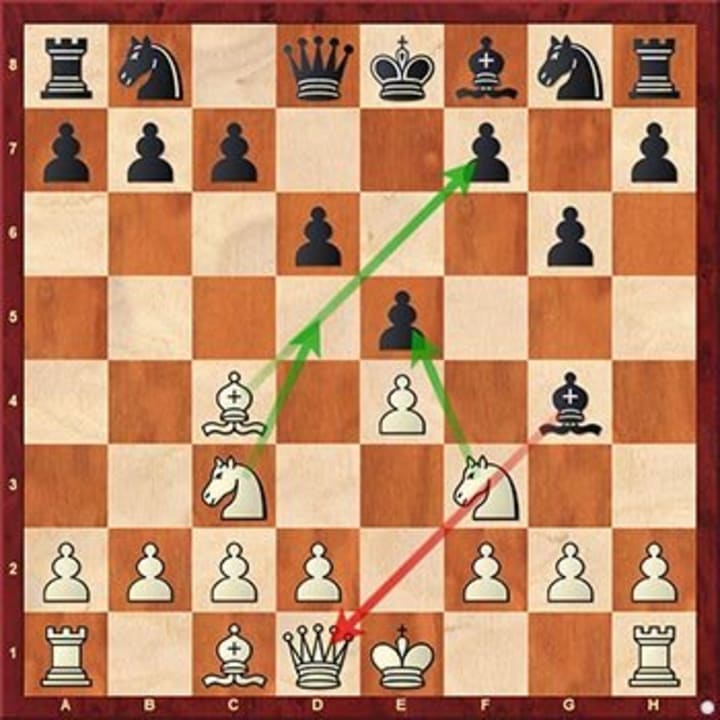
Chess Tactics 5: Absolute Bunch
When the king is behind the connected figure, such a bunch is called absolute. As you could see from the previous example, the relative ligament can be broken if given a chance. The situation is different with absolute connectivity.

Chess Tactics 6: Through Attack
This tactic is sometimes called "an inverted bundle", because here a more valuable figure is facing a less valuable one.

Chess Tactics 7: Distraction
Also one of the most common tactical techniques. Sometimes the figure of the enemy interferes with your plans; in this case, you can try to distract her with your other figures. The brightest examples of bait are endgame. You can donate one of your pawns to turn the other.
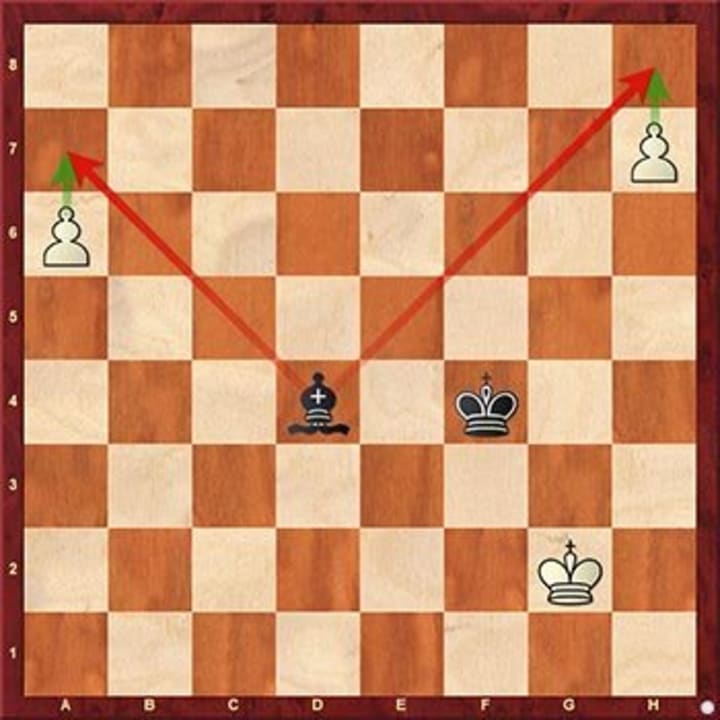
Chess Tactics 8: Using the Last Horizontal
In the next position, a white rook can put a mat to the king of blacks due to the weakness of the last row. On the other hand, the white king has a field for escape on h2, which makes him absolutely safe against such chess tactics.

Chess Tactics 9: Double Mine
As a rule, to protect yourself from the Shah, you can move the king, block or take the figure that gives the shah. Against a double Shah, the only way to defend oneself is to make a move king. This makes this chess tactics very effective.

Chess Tactics 10: Engagement
This technique helps when you need your opponent’s figure to be in a certain field in order to achieve something. In the diagram above after 1 ... Kh8, whites put the mat in two moves. They begin with the move 2.Qg8, attracting black rooks to the g8 field.

Chess Tactics 11: Sturdy Mate
After taking the black rook queen, And after 3.Nf7 whites are becoming dull! This tactic is called a stolen mat. As you can see, to put on a stolen mat, whites used a double shaft and a lure. Remember this sequence; This is a very common combination in chess.

Chess Tactics 12: Extraction of the King
This combination aims to put the enemy king in an unprotected position, often even at the cost of some material. In the next position, whites can play Gambit Kohren, starting at 4.Nxf7. The idea of this crazy move is to get the black king to go to the center and attack him there.

Chess tactics 13: Greek Gift
This is a case of the extraction of the king and one of the most famous combinations. White donates an elephant on h7 (or black on h2 with inverted colors), after which usually the horse goes on g5, and the queen on h5 with inevitable matte threats.

Chess Tactics 14: Lasker Victim
This chess tactic is similar to the Greek gift move and also begins with Bxh7. The difference is that both elephants are sacrificed here! The idea is to open the black king and put the mate on open lines g and h. So after 1.Bxh7 Kxh7 2.Qxh5 + Kg7 whites donate another elephant in 3.Bxg7 Kxg7 4.Qg4 + Kh8 to put the mat after 5.Rf3 followed by Rh3.
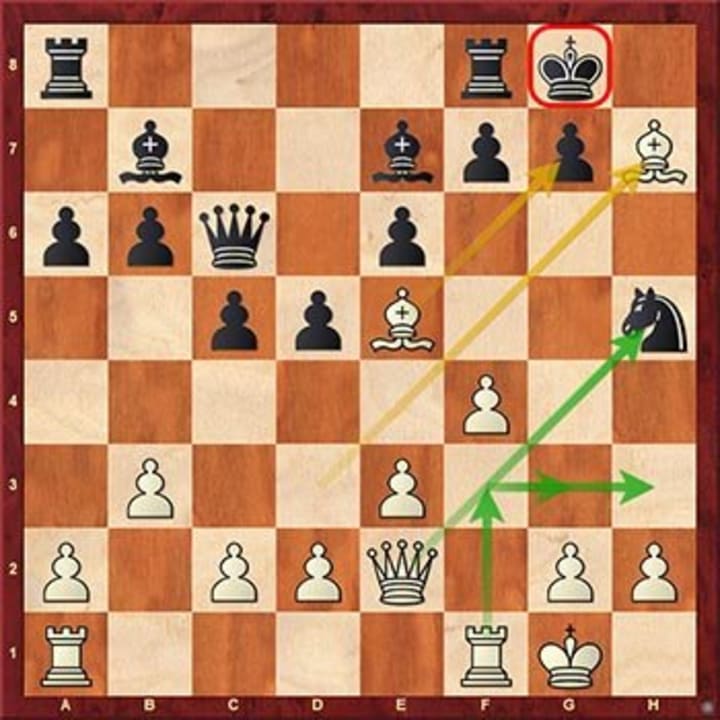
Chess tactics 15: Removal of the Defender
Instead of distracting a figure, you can also destroy it. This works especially well when it can be removed using a checker. In the next position, whites can win the queen after 1.Bxc6 + and 2.Qxd4.

Chess Tactics 16: X-Ray
Beginners often miss this chess tactics. Farms, rooks and elephants can control the fields even behind the figure if this figure is going to walk. Despite the fact that the queen does not currently control the g6 field, the king still cannot get there.

Chess Tactics 17: Fishing Figures
Sometimes less valuable figures surround and attack a more valuable figure. In the next position, the black queen has no way out and falls into the trap. Please note that the b1 rook also translates the fields behind the queen.

Chess Tactics 18: Open Attack
In the next position, any jump of the horse with f7 would lead to the chalice with an elephant with c4. 1.Nh6 leads to a double Shah, but it was best to play 1.Nd6 and take the queen.

Chess tactics 19: Mill
This is a very powerful chess tactic based on repeated overt attacks. The most famous example of a chess mill is a game played by Carlos Torre Repetto against Emanuel Lasker, where a young Mexican donated a queen to defeat the former world champion.
The mill mechanism is simple; after 1.Rxf7 + Kg8 2.Rg7 +! Kh8 Torre got the same position without the pawn f7. Then he did the same with an elephant on b7: 3.Rxb7 + Kg8 4.Rg7 + Kh8. And then finally took the queen after 5.Rg5 + Kh7 6.Rxh5.

Chess Tactics 20: Countering the Threat
Instead of defending or moving your figure, you can counterattack the opponent’s piece. In the next position after 12.g5, blacks can play 12 ... b4 by counterattacking the white horse.
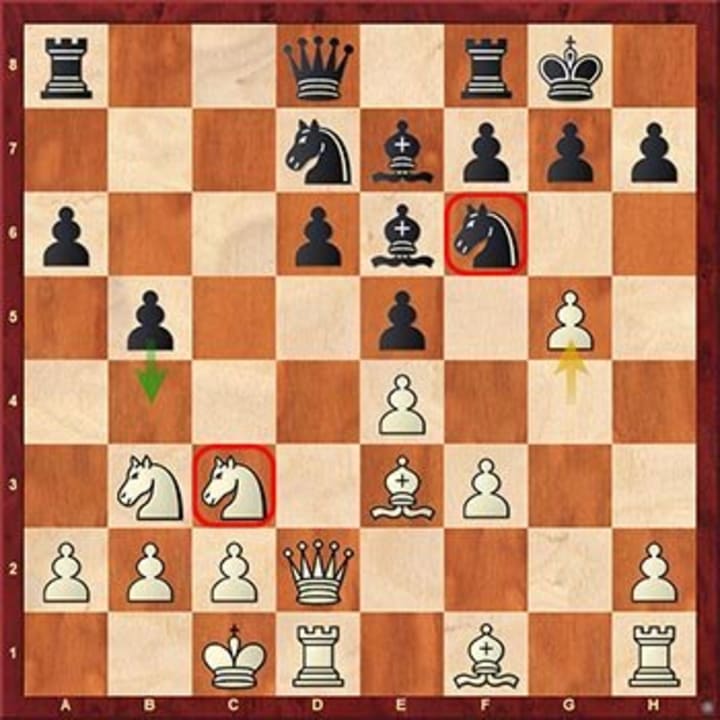
Chess Tactics 21: Intermediate Move
The situation when you insert the checker, threat or capture between other moves. In this position, in case 1 ... Qxd2, whites can first play 2.Nxe7 + and only then pick up the queen.
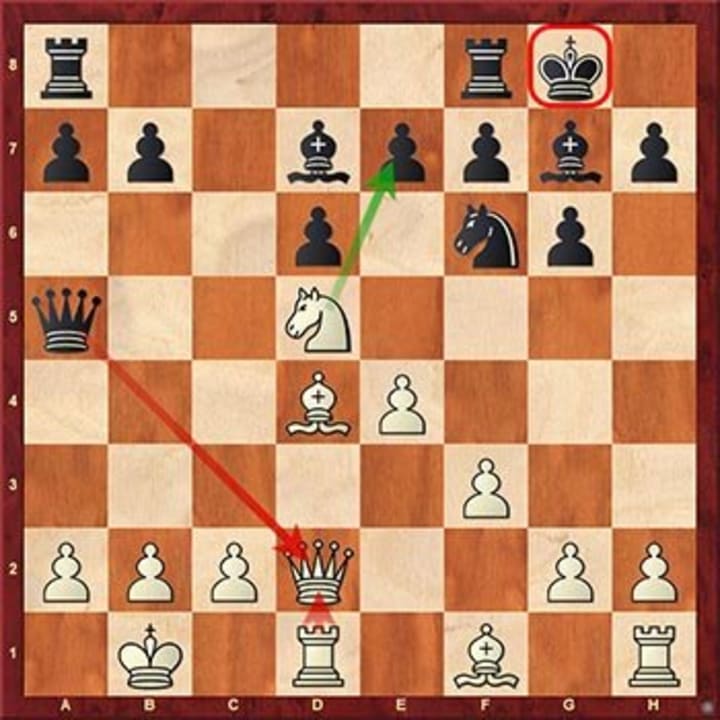
Chess Tactics 22: Zugtsvang
In the next position there are blacks, but any possible move will only worsen their position. This situation is called Zugtsvang. In this position, any move of blacks allows the white king to break through and win pawns.

Chess Tactics 23: Simplification
It is important to understand that change reduces not only the potential of your position, but also reduces the capabilities of your opponent. In the next position, the black rook would easily stop the passing white, but after 1.Rd8 + Rf8 2.Rxf8 Kxf8 3.a5 pawn cannot be stopped.

Chess Tactics 24: Pat
Tactics based on a stalemate usually occurs when there are few figures on the board. The following example is pretty clear; move 1 ... Rd6! black « pierce » white figures and create pat after 2.Kxd6.

Chess Tactics 25: Linear Mat
One of the popular combinations of – linear mat completes our selection. The idea is simple: one rook cuts off the king, and the other puts him a mat. But sometimes such an idea is quite difficult to notice. Here, whites give a linear mat after the queen victim: 1.Qxh7! Kxh7 2.Rh5#

Conclusion:
Now that you know what chess combinations exist, it will be easier for you to diagnose them in your part of the game. But, of course, do not forget and solve more problems for each of the considered techniques in order to train your ability to detect them on the board.
NOTE: If you are striving for a sharp increase in the chess level, you need to systematically work on all elements of the game:
- Tactics
- Position game
- Attacking skills
- Endgame Technique
- Analysis of classic games
- Psychological training
- And much more
About the Creator
Temoor Dar
💡Topic: Entrepreneur and Writer💡
♟️Hobbies: Traveling, Poems, Playing Chess and Solving Puzzles♟️
🎂Born: July 7, 1991🎂
📍Born in Stockholm, Sweden, and now a Londoner since 1996📍
📚Lifelong Learner📚
🌟Wisdom from Mentors🌟






Comments
There are no comments for this story
Be the first to respond and start the conversation.